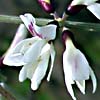White Broom is a perennial shrub, which reaches a height of up to 3 meters. It is impressive mainly due to its opulent blossoming. The plant is covered with dense silk hairs (hirsute). It has thin and flexible branches, which are silvery green when young and dark green when mature. They are grooved with delicate longitudinal grooves which contain the stomata. Its roots penetrate the soil to a great depth (some claim up to 20 meters), and they reach water even after the upper soil layers have dried. The leaves are simple, narrow and elongated, with a length of 10 mm. They fall a short time after sprouting, and the tree plant remains leafless for most of the year, with photosynthetic activity taking place in the thin stems. The stomata are hidden within the longitudinal grooves of the stem, such that water loss during photosynthesis is reduced.
Retama raetam blooms between January and April. The calyx has two lips, is dark purple, and sometimes there are spots of a similar color also on the corolla. There are two teeth on the upper lip of the calyx. The lower lip is somewhat elongated and has three teeth. The corolla is typical of the Fabaceae family, and is bright white. The standard is prominent, with purple veins, and a length of 12 mm and width of 10 mm. The flower emits a pleasant scent. The filaments of the stamen are fused into a duct, and disperse their pollen by a method called “explosion pollination”. The scent of the flower attracts insects, especially bees. Each flower is attached to a stem via a short pedicel. The fruit is a short single-seed legumen, ovate, with an acute apex. It is glabrous, and does not open when ripe. The seed is yellow, with a very hard coat. The legumens are eaten mainly by rabbits. The seeds are not digested and are excreted in the droppings. The action of the digestive juices on the hard coat of the seeds facilitates their germination. Seeds that remained in legumens will germinate when the legumen shell rots and the seed absorbs water.
Retama raetam is common in most regions of Israel, except for the mountains of the north and center. It grows especially in lithified desert and seashore dunes; in regions of migrating and stabilized dunes in the coastal plain and the lowland; and also (perhaps a different variety) on rocky slopes in the desert; on rocks and roadsides in the Golan Heights, Mount Carmel and Eastern Samaria. Its global distribution extends over the deserts of North Africa and South Asia. The genus contains 5 species. The shrub is also common in ornamental gardens. The fruit vales are edible. It is used by desert Bedouin as medicine for treatment of backache, stomachache, infertility, temporary paralysis of the limbs, joint pain, infected skin lesions, toothache, sprains and fractures.
Written by Erga Aloni and Mike Livne








